Lunar Mare Fecunditatis: A Science-Rich Region and a Concept Mission for Long-Distance Exploration
Abstract
1. Introduction
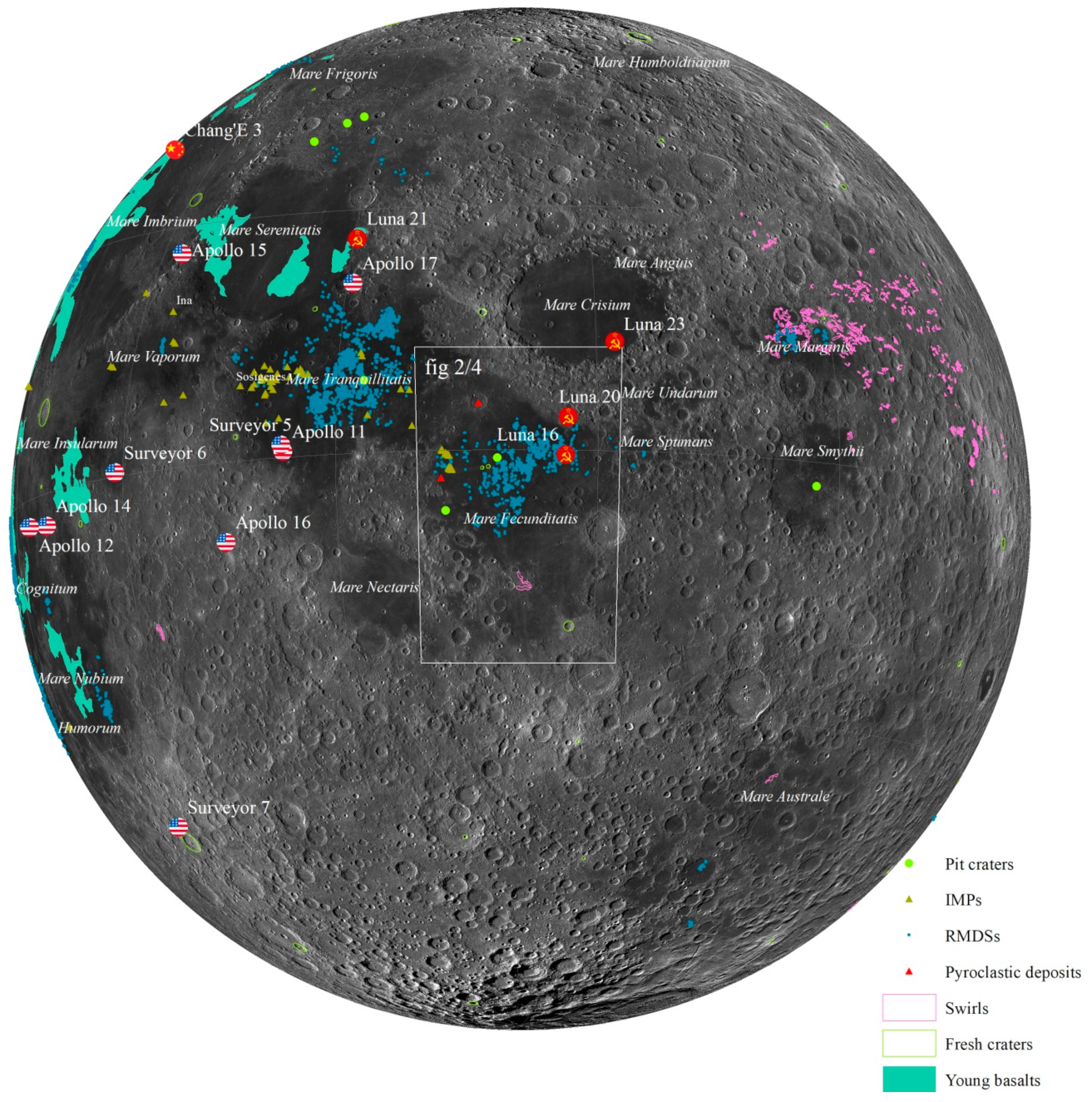
2. Topography of Mare Fecunditatis
3. Geology and Geomorphology of Mare Fecunditatis
3.1. Volcanic Features
3.1.1. Mare Basalts
3.1.2. Sinuous Rilles
3.1.3. Floor-Fractured Craters
3.1.4. Pyroclastic Deposits
3.1.5. Irregular Mare Patches
3.1.6. Domes
3.1.7. Ring-Moat Dome Structures
3.2. Tectonic Features
3.2.1. Wrinkle Ridges
3.2.2. Arcuate Rilles and Grabens
3.3. Impact Craters
3.4. Other Features
3.4.1. Pit Craters
3.4.2. Swirls
4. Discussion
4.1. High-Value Detection Targets
4.1.1. Pit Craters
4.1.2. Young Volcanism
4.1.3. High-Al Basalts
4.1.4. Pyroclastic Deposits
4.1.5. Swirls
4.1.6. Fresh Craters
4.2. Traverse Design for Long-Distance Detection
5. Conclusions
Author Contributions
Funding
Data Availability Statement
Acknowledgments
Conflicts of Interest
References
- National Research Council. The Scientific Context for Exploration of the Moon; The National Academies Press: Washington, DC, USA, 2007; ISBN 978-0-309-10919-2. [Google Scholar]
- Flahaut, J.; Blanchette-Guertin, J.-F.; Jilly, C.; Sharma, P.; Souchon, A.; van Westrenen, W.; Kring, D.A. Identification and characterization of science-rich landing sites for lunar lander missions using integrated remote sensing observations. Adv. Space Res. 2012, 50, 1647–1665. [Google Scholar] [CrossRef]
- Jawin, E.R.; Valencia, S.N.; Watkins, R.N.; Crowell, J.M.; Neal, C.R.; Schmidt, G. Lunar Science for Landed Missions Workshop Findings Report. Earth Space Sci. 2019, 6, 2–40. [Google Scholar] [CrossRef]
- Kring, D.A.; Durda, D.D. (Eds.) A Global Lunar Landing Site Study to Provide the Scientific Context for Exploration of the Moon; National Academies Press: Washington, DC, USA, 2012. [Google Scholar]
- Hiesinger, H.; van der Bogert, C.H.; Wedler, A.; Jaumann, R.; Mall, U.; Head, J.W.; Anand, M.; Jolliff, B.; Pinet, P.; Xiao, L.; et al. The Rima Bode Region—Candidate for a Future Lunar Landing Site. In Proceedings of the 52nd Lunar and Planetary Science Conference, Virtual Event, 15–19 March 2021; p. 1485. [Google Scholar]
- Flahaut, J.; Carpenter, J.; Williams, J.-P.; Anand, M.; Crawford, I.A.; van Westrenen, W.; Füri, E.; Xiao, L.; Zhao, S. Regions of interest (ROI) for future exploration missions to the lunar South Pole. Planet. Space Sci. 2019, 180, 104750. [Google Scholar] [CrossRef]
- Lemelin, M.; Blair, D.M.; Roberts, C.E.; Runyon, K.D.; Nowka, D.; Kring, D.A. High-priority lunar landing sites for in situ and sample return studies of polar volatiles. Planet. Space Sci. 2014, 101, 149–161. [Google Scholar] [CrossRef]
- Robinson, M.S.; Blewett, D.T.; Frank, E.; Illsley, P.; Lawrence, S.; Mahanti, P.; Rampe, E.B.; Speyerer, E.J.; Stopar, J.; Tikoo, S.; et al. Intrepid: Lunar Roving Prospector. In Proceedings of the AGU Fall Meeting, San Francisco, CA, USA, 9–13 December 2019; American Geophysical Union: Washington, DC, USA, 2019; p. P33D-03. [Google Scholar]
- Zhang, C.; Xu, W.; Wang, Y. Development Ideas of Manned Lunar Surface Exploration. Aerosp. Shanghai 2021, 38, 109–118. [Google Scholar] [CrossRef]
- Wilhelms, D.E.; McCauley, J.F. Geologic Map of the Near Side of the MOON; IMAP 1971; USGS: Reston, VI, USA, 1971. [CrossRef]
- Wilhelms, D.E.; McCauley, J.F.; Trask, N.J. The Geologic History of the Moon; Professional Paper; USGS: Reston, VI, USA, 1987. [Google Scholar] [CrossRef]
- Hiesinger, H.; Head, J.W.; Wolf, U.; Jaumann, R.; Neukum, G. New Ages for Basalts in Mare Fecunditatis Based on Crater Size-Frequency Measurements. In Proceedings of the 37th Lunar and Planetary Science Conference, The Woodlands, Houston, TX, USA, 13–27 March 2006; p. 1151. [Google Scholar]
- Robinson, M.S.; Brylow, S.M.; Tschimmel, M.; Humm, D.; Lawrence, S.J.; Thomas, P.C.; Denevi, B.W.; Bowman-Cisneros, E.; Zerr, J.; Ravine, M.A.; et al. Lunar Reconnaissance Orbiter Camera (LROC) Instrument Overview. Space Sci. Rev. 2010, 150, 81–124. [Google Scholar] [CrossRef]
- Wagner, R.V.; Robinson, M.S. Occurrence and Origin of Lunar Pits: Observations from a New Catalog. In Proceedings of the 52nd Lunar and Planetary Science Conference, Virtual Event, 15–19 March 2021. [Google Scholar]
- Braden, S.E.; Stopar, J.D.; Robinson, M.S.; Lawrence, S.J.; van der Bogert, C.H.; Hiesinger, H. Evidence for basaltic volcanism on the Moon within the past 100 million years. Nat. Geosci. 2014, 7, 787–791. [Google Scholar] [CrossRef]
- Zhang, F.; Head, J.W.; Wöhler, C.; Bugiolacchi, R.; Wilson, L.; Basilevsky, A.T.; Grumpe, A.; Zou, Y.L. Ring-Moat Dome Structures (RMDSs) in the Lunar Maria: Statistical, Compositional, and Morphological Characterization and Assessment of Theories of Origin. J. Geophys. Res. 2020, 125, e2019JE005967. [Google Scholar] [CrossRef]
- Gaddis, L.R.; Staid, M.I.; Tyburczy, J.A.; Hawke, B.; Petro, N.E. Compositional analyses of lunar pyroclastic deposits. Icarus 2003, 161, 262–280. [Google Scholar] [CrossRef]
- Gustafson, J.O.; Bell, J.F.; Gaddis, L.R.; Hawke, B.R.; Giguere, T.A. Characterization of previously unidentified lunar pyroclastic deposits using Lunar Reconnaissance Orbiter Camera data. J. Geophys. Res. 2012, 117, e12. [Google Scholar] [CrossRef]
- Denevi, B.W.; Robinson, M.S.; Boyd, A.K.; Blewett, D.T.; Klima, R.L. The distribution and extent of lunar swirls. Icarus 2016, 273, 53–67. [Google Scholar] [CrossRef]
- Ravi, S.; Meyer, H.M.; Mahanti, P.; Robinson, M.S. On the usefulness of optical maturity for relative age classification of fresh craters. In Proceedings of the AGU Fall Meeting, San Francisco, CA, USA, 12–16 December 2016; p. P53A-2166. [Google Scholar]
- Hiesinger, H.; Head, J.W.; Wolf, U.; Jaumann, R.; Neukum, G. Ages and stratigraphy of lunar mare basalts: A synthesis. In Geological Society of America Special Papers: Recent Advances and Current Research Issues in Lunar Stratigraphy; Geological Society of America: Boulder, CO, USA, 2011; p. 477. [Google Scholar] [CrossRef]
- Hiesinger, H.; Head, J.W. Ages and stratigraphy of mare basalts in Oceanus Procellarum, Mare Nubium, Mare Cognitum, and Mare Insularum. J. Geophys. Res. 2003, 108, e7. [Google Scholar] [CrossRef]
- Hiesinger, H.; Head, J.W.; Wolf, U.; Jaumann, R.; Neukum, G. Lunar mare basalt flow units: Thicknesses determined from crater size-frequency distributions. Geophys. Res. Lett. 2002, 29, 89-1–89-4. [Google Scholar] [CrossRef]
- Hiesinger, H.; Head, J.W.; Wolf, U.; Jaumann, R.; Neukum, G. Ages and stratigraphy of lunar mare basalts in Mare Frigoris and other nearside maria based on crater size-frequency distribution measurements. J. Geophys. Res. 2010, 115, e3. [Google Scholar] [CrossRef]
- Hiesinger, H.; Jaumann, R.; Neukum, G.; Head, J.W. Ages of mare basalts on the lunar nearside. J. Geophys. Res. 2000, 105, 29239–29275. [Google Scholar] [CrossRef]
- Barker, M.K.; Mazarico, E.; Neumann, G.A.; Zuber, M.T.; Haruyama, J.; Smith, D.E. A new lunar digital elevation model from the Lunar Orbiter Laser Altimeter and SELENE Terrain Camera. Icarus 2016, 273, 346–355. [Google Scholar] [CrossRef]
- McCauley, J.F.; Scott, D.H. The geologic setting of the Luna 16 landing site. Earth Planet. Sci. Lett. 1972, 13, 225–232. [Google Scholar] [CrossRef]
- Rosenburg, M.A.; Aharonson, O.; Head, J.W.; Kreslavsky, M.A.; Mazarico, E.; Neumann, G.A.; Smith, D.E.; Torrence, M.H.; Zuber, M.T. Global surface slopes and roughness of the Moon from the Lunar Orbiter Laser Altimeter. J. Geophys. Res. 2011, 116, E11007. [Google Scholar] [CrossRef]
- Zuber, M.T.; Smith, D.E.; Zellar, R.S.; Neumann, G.A.; Sun, X.; Katz, R.B.; Kleyner, I.; Matuszeski, A.; McGarry, J.F.; Ott, M.N.; et al. The Lunar Reconnaissance Orbiter Laser Ranging Investigation. Space Sci. Rev. 2010, 150, 63–80. [Google Scholar] [CrossRef]
- Smith, D.E.; Zuber, M.T.; Jackson, G.B.; Cavanaugh, J.F.; Neumann, G.A.; Riris, H.; Sun, X.; Zellar, R.S.; Coltharp, C.; Connelly, J.; et al. The Lunar Orbiter Laser Altimeter Investigation on the Lunar Reconnaissance Orbiter Mission. Space Sci. Rev. 2010, 150, 209–241. [Google Scholar] [CrossRef]
- Muller, P.M.; Sjogren, W.L. Mascons: Lunar Mass Concentrations. Science 1968, 161, 680–684. [Google Scholar] [CrossRef]
- Neumann, G.A.; Zuber, M.T.; Wieczorek, M.A.; Head, J.W.; Baker, D.M.H.; Solomon, S.C.; Smith, D.E.; Lemoine, F.G.; Mazarico, E.; Sabaka, T.J.; et al. Lunar impact basins revealed by Gravity Recovery and Interior Laboratory measurements. Sci. Adv. 2015, 1, e1500852. [Google Scholar] [CrossRef]
- Hurwitz, D.M.; Head, J.W.; Hiesinger, H. Lunar sinuous rilles: Distribution, characteristics, and implications for their origin. Planet. Space Sci. 2013, 79–80, 1–38. [Google Scholar] [CrossRef]
- Yue, Z.; Li, W.; Di, K.; Liu, Z.; Liu, J. Global mapping and analysis of lunar wrinkle ridges. J. Geophys. Res. 2015, 120, 978–994. [Google Scholar] [CrossRef]
- Jozwiak, L.M.; Head, J.W.; Zuber, M.T.; Smith, D.E.; Neumann, G.A. Lunar floor-fractured craters: Classification, distribution, origin and implications for magmatism and shallow crustal structure. J. Geophys. Res. 2012, 117, 6. [Google Scholar] [CrossRef]
- Rajmon, D.; Spudis, P. Distribution and stratigraphy of basaltic units in Maria Tranquillitatis and Fecunditatis: A Clementine perspective. Meteorit. Planet. Sci. 2004, 39, 1699–1720. [Google Scholar] [CrossRef]
- Dehon, R.A. Mare Fecunditatis: Basin Configuration. In Proceedings of the Conference on Origins of Mare Basalts and Their Implications for Lunar Evolution, The Woodlands, Houston, TX, USA, 17–19 November 1975; Lunar Science Institute: Houston, TX, USA, 1975; p. 32. [Google Scholar]
- Ohtake, M.; Haruyama, J.; Matsunaga, T.; Yokota, Y.; Morota, T.; Honda, C. Performance and scientific objectives of the SELENE (KAGUYA) Multiband Imager. Earth Planets Space 2008, 60, 257–264. [Google Scholar] [CrossRef]
- Otake, H.; Ohtake, M.; Hirata, N. Lunar Iron and Titanium Abundance Algorithms Based on SELENE (Kaguya) Multiband Imager Data. In Proceedings of the 43rd Lunar and Planetary Science Conference, The Woodlands, Houston, TX, USA, 19–23 March 2012; p. 1905. [Google Scholar]
- Lemelin, M.; Lucey, P.G.; Gaddis, L.R.; Hare, T.; Ohtake, M. Global Map Products from the Kaguya Multiband Imager at 512 ppd: Minerals, FeO, and OMAT. In Proceedings of the 47th Lunar and Planetary Science Conference, The Woodlands, Houston, TX, USA, 21–25 March 2016; p. 2994. [Google Scholar]
- Sato, H.; Robinson, M.S.; Lawrence, S.J.; Denevi, B.W.; Hapke, B.; Jolliff, B.L.; Hiesinger, H. Lunar mare TiO2 abundances estimated from UV/Vis reflectance. Icarus 2017, 296, 216–238. [Google Scholar] [CrossRef]
- Wu, Y.; Besse, S.; Li, J.-Y.; Combe, J.-P.; Wang, Z.; Zhou, X.; Wang, C. Photometric correction and in-flight calibration of Chang’ E-1 Interference Imaging Spectrometer (IIM) data. Icarus 2013, 222, 283–295. [Google Scholar] [CrossRef]
- Ouyang, Z.; Li, C.; Zou, Y.; Zhang, H.; Lü, C.; Liu, J.; Liu, J.; Zuo, W.; Su, Y.; Wen, W.; et al. Primary scientific results of Chang’E-1 lunar mission. Sci. China Earth Sci. 2010, 53, 1565–1581. [Google Scholar] [CrossRef]
- Xia, W.; Wang, X.; Zhao, S.; Jin, H.; Chen, X.; Yang, M.; Wu, X.; Hu, C.; Zhang, Y.; Shi, Y.; et al. New maps of lunar surface chemistry. Icarus 2019, 321, 200–215. [Google Scholar] [CrossRef]
- Kramer, G.Y.; Jolliff, B.L.; Neal, C.R. Distinguishing high-alumina mare basalts using Clementine UVVIS and Lunar Prospector GRS data: Mare Moscoviense and Mare Nectaris. J. Geophys. Res. 2008, 113, 10. [Google Scholar] [CrossRef]
- Kramer, G.Y.; Jolliff, B.L.; Neal, C.R. Searching for high alumina mare basalts using Clementine UVVIS and Lunar Prospector GRS data: Mare Fecunditatis and Mare Imbrium. Icarus 2008, 198, 7–18. [Google Scholar] [CrossRef]
- Kurat, G.; Kracher, A.; Keil, K.; Warner, R.; Prinz, M. Composition and origin of Luna 16 aluminous mare basalts. In Lunar and Planetary Science Conference Proceedings; Pergamon Press: New York, NY, USA, 1976; Volume 2, pp. 1301–1321. [Google Scholar]
- Ma, M.-S.; Schmitt, R.A.; Nielsen, R.L.; Taylor, G.J.; Warner, R.D.; Keil, K. Petrogenesis of Luna 16 aluminous Mare basalts. Geophys. Res. Lett. 1979, 6, 909–912. [Google Scholar] [CrossRef]
- Huneke, J.C.; Podosek, F.A.; Wasserburg, G.J. Gas retention and cosmic-ray exposure ages of a basalt fragment from Mare Fecunditatis. Earth Planet. Sci. Lett. 1972, 13, 375–383. [Google Scholar] [CrossRef]
- Cadogan, P.H.; Turner, G. 40Ar-39Ar dating of Luna 16 and Luna 20 samples. Phil. Trans. R. Soc. Lond. A 1977, 284, 167–177. [Google Scholar] [CrossRef]
- Cohen, B.A.; Snyder, G.A.; Hall, C.M.; Taylor, L.A.; Nazarov, M.A. Argon-40-argon-39 chronology and petrogenesis along the eastern limb of the Moon from Luna 16, 20 and 24 samples. Meteorit. Planet. Sci. 2001, 36, 1345–1366. [Google Scholar] [CrossRef]
- Fernades, V.A.; Burgess, R. Volcanism in Mare Fecunditatis and Mare Crisium: Ar-Ar age studies. Geochim. Cosmochim. Acta 2005, 69, 4919–4934. [Google Scholar] [CrossRef]
- Haruyama, J.; Ohtake, M.; Matsunaga, T.; Morota, T.; Yokota, Y.; Honda, C.; Hirata, N.; Demura, H.; Iwasaki, A.; Nakamura, R.; et al. Planned radiometrically calibrated and geometrically corrected products of lunar high-resolution Terrain Camera on SELENE. Adv. Space Res. 2008, 42, 310–316. [Google Scholar] [CrossRef]
- Greeley, R. Lunar hadley rille: Considerations of its origin. Science 1971, 172, 722–725. [Google Scholar] [CrossRef]
- Jozwiak, L.M.; Head III, J.W.; Neumann, G.A.; Wilson, L. Observational constraints on the identification of shallow lunar magmatism: Insights from floor-fractured craters. Icarus 2017, 283, 224–231. [Google Scholar] [CrossRef]
- Jozwiak, L.M.; Head, J.W.; Wilson, L. Lunar floor-fractured craters as magmatic intrusions: Geometry, modes of emplacement, associated tectonic and volcanic features, and implications for gravity anomalies. Icarus 2015, 248, 424–447. [Google Scholar] [CrossRef]
- Hall, J.L.; Solomon, S.C.; Head, J.W. Lunar floor-fractured craters: Evidence for viscous relaxation of crater topography. J. Geophys. Res. Solid Earth 1981, 86, 9537–9552. [Google Scholar] [CrossRef]
- Wichman, R.W.; Schultz, P.H. Floor-fractured craters in Mare Smythii and west of Oceanus Procellarum: Implications of crater modification by viscous relaxation and igneous intrusion models. J. Geophys. Res. 1995, 100, 21201–21218. [Google Scholar] [CrossRef]
- Dombard, A.J.; Gillis, J.J. Testing the viability of topographic relaxation as a mechanism for the formation of lunar floor-fractured craters. J. Geophys. Res. 2001, 106, 27901–27909. [Google Scholar] [CrossRef]
- Hiesinger, H.; Head, J.W. New Views of Lunar Geoscience: An Introduction and Overview. Rev. Mineral. Geochem. 2006, 60, 1–81. [Google Scholar] [CrossRef]
- Gaddis, L.R. Progress toward characterization of juvenile materials in lunar pyroclastic deposits. In Workshop on New Views of the Moon 2: Understanding the Moon Through the Integration of Diverse Datasets; Gaddis, L., Shearer, C.K., Eds.; Lunar and Planetary Institute: Houston, TX, USA, 1999. [Google Scholar]
- Spudis, P.D. Young dark mantle deposits on the Moon. In Proceedings of the Workshop on Lunar Volcanic Glasses: Scientific and Resource Potential, Houston, TX, USA, 10–11 October 1989; LPI Technical Report 90-02. Delano, J.W., Heiken, G.H., Eds.; Lunar and Planetary Institute: Houston, TX, USA, 1990; p. 60. [Google Scholar]
- Whitaker, E.A. An Unusual Mare Feature. In Apollo 15: Preliminary Science Report; Swann, G.A., Bailey, N.G., Batson, R.M., Freeman, V.L., Hait, M.H., Head, J.W., Holt, H.E., Howard, K.A., Irwin, J.B., Larson, K.B., et al., Eds.; NASA: Washington, DC, USA, 1972; p. 84. [Google Scholar]
- El-Baz, F. New geological findings in Apollo 15 lunar orbital photography. In Proceedings of the Third Lunar Science Con-ference, Houston, TX, USA, 10 January 1972. [Google Scholar]
- El-Baz, F. “D-Caldera”: New Photographs of a Unique Feature. In Apollo 17: Preliminary Science Report; Renner, K., Ed.; NASA: Washington, DC, USA, 1973. [Google Scholar]
- Strain, P.L.; El-Baz, F. The geology and morphology of Ina. In Proceedings of the 11th Lunar and Planetary Science Conference, The Woodlands, Houston, TX, USA, 17–21 March 1980; Pergamon Press: New York, NY, USA, 1980; pp. 2437–2446. [Google Scholar]
- Schultz, P.H.; Staid, M.I.; Pieters, C.M. Lunar activity from recent gas release. Nature 2006, 444, 184–186. [Google Scholar] [CrossRef]
- Garry, W.B.; Robinson, M.S.; Zimbelman, J.R.; Bleacher, J.E.; Hawke, B.R.; Crumpler, L.S.; Braden, S.E.; Sato, H. The origin of Ina: Evidence for inflated lava flows on the Moon. J. Geophys. Res. 2012, 117, e12. [Google Scholar] [CrossRef]
- Carter, L.M.; Hawke, B.R.; Garry, W.B.; Campbell, B.A.; Giguere, T.A.; Bussey, D.B.J. Radar Observations of Lunar Hollow Terrain. In Proceedings of the 44th Lunar and Planetary Science Conference, The Woodlands, Houston, TX, USA, 18–22 March 2013; p. 2146. [Google Scholar]
- Qiao, l.; Head, J.; Wilson, L.; Xiao, L.; Kreslavsky, M.; Dufek, J. Ina pit crater on the Moon: Extrusion of waning-stage lava lake magmatic foam results in extremely young crater retention ages. Geology 2017, 45, 455–458. [Google Scholar] [CrossRef]
- Wilson, L.; Head, J.W. Eruption of magmatic foams on the Moon: Formation in the waning stages of dike emplacement events as an explanation of “irregular mare patches”. J. Volcanol. Geotherm. Res. 2017, 335, 113–127. [Google Scholar] [CrossRef]
- Qiao, l.; Head, J.W.; Xiao, L.; Wilson, L.; Dufek, J.D. The role of substrate characteristics in producing anomalously young crater retention ages in volcanic deposits on the Moon: Morphology, topography, subresolution roughness, and mode of emplacement of the Sosigenes lunar irregular mare patch. Meteorit. Planet. Sci. 2018, 53, 778–812. [Google Scholar] [CrossRef]
- Qiao, l.; Head, J.W.; Ling, Z.; Wilson, L.; Xiao, L.; Dufek, J.D.; Yan, J. Geological Characterization of the Ina Shield Volcano Summit Pit Crater on the Moon: Evidence for Extrusion of Waning-Stage Lava Lake Magmatic Foams and Anomalously Young Crater Retention Ages. J. Geophys. Res. 2019, 124, 1100–1140. [Google Scholar] [CrossRef]
- Head, J.W.; Wilson, L. Generation, ascent and eruption of magma on the Moon: New insights into source depths, magma supply, intrusions and effusive/explosive eruptions (Part 2: Predicted emplacement processes and observations). Icarus 2017, 283, 176–223. [Google Scholar] [CrossRef]
- Wöhler, C.; Lena, R.; Lazzarotti, P.; Phillips, J.; Wirths, M.; Pujic, Z. A combined spectrophotometric and morphometric study of the lunar mare dome fields near Cauchy, Arago, Hortensius, and Milichius. Icarus 2006, 183, 237–264. [Google Scholar] [CrossRef]
- Huang, Q.; Zhao, J.; Wang, X.; Wang, T.; Zhang, F.; Qiao, L.; Chen, Y.; Qiu, D.; Yang, Y.; Xiao, L. A large long-lived central-vent volcano in the Gardner region: Implications for the volcanic history of the nearside of the Moon. Earth Planet. Sci. Lett. 2020, 542, 116301. [Google Scholar] [CrossRef]
- Zhang, F.; Head, J.W.; Basilevsky, A.T.; Bugiolacchi, R.; Komatsu, G.; Wilson, L.; Fa, W.; Zhu, M.-H. Newly Discovered Ring-Moat Dome Structures in the Lunar Maria: Possible Origins and Implications. Geophys. Res. Lett. 2017, 44, 9216–9224. [Google Scholar] [CrossRef]
- Basilevsky, A.T.; Zhang, F.; Wöhler, C.; Bugiolacchi, R.; Head, J.W.; Wilson, L. Lunar Ring-Moat Dome Structures and Their Relationships with Small Impact Craters. In Proceedings of the 50th Lunar and Planetary Science Conference, The Woodlands, Houston, TX, USA; 2019; p. 1507. [Google Scholar]
- Zhang, F.; Head, J.W.; Wöhler, C.; Basilevsky, A.T.; Wilson, L.; Xie, M.; Bugiolacchi, R.; Wilhelm, T.; Althoff, S.; Zou, Y.L. The Lunar Mare Ring-Moat Dome Structure (RMDS) Age Conundrum: Contemporaneous with Imbrian-Aged Host Lava Flows or Emplaced in the Copernican? J. Geophys. Res. Planets 2021, 126, e2021JE006880. [Google Scholar] [CrossRef]
- Bryan, W.B. Wrinkle-ridges as deformed surface crust on ponded mare lava. In Proceedings of the Fourth Lunar Science Conference, The Woodlands, Houston, TX, USA, 17 March 1973; Pergamon Press: New York, NY, USA, 1973. [Google Scholar]
- Howard, K.A.; Muehlberger, W.R. Mare ridges and related studies: Part C: Lunar thrust faults in the Taurus-Littrow region. In Apollo 17: Preliminary Science Report; Renner, K., Ed.; NASA: Washington, DC, USA, 1973. [Google Scholar]
- Lucchitta, B.K. Mare ridges and related highland scarps-Result of vertical tectonism. In Proceedings of the Seventh Lunar Science Conference, Houston, TX, USA, 15–19 March 1976. [Google Scholar]
- Quaide, W. Rilles, ridges, and domes—Clues to maria history. Icarus 1965, 4, 374–389. [Google Scholar] [CrossRef]
- Strom, R.G. Lunar Mare Ridges, Rings and Volcanic Ring Complexes. In The Moon, Proceedings from IAU Symposium No. 47, the University of Newcastle-Upon-Tyne England, 22–26 March 1971; Runcorn, S.K., Urey, H.C., Eds.; Springer International Publishing: Cham, Switzerland, 1972; pp. 187–215. ISBN 978-94-010-2861-5. [Google Scholar]
- Scott, D.H. Mare ridges and related studies: Part D: Small structures of the Taurus-Littrow region. In Apollo 17: Preliminary Science Report; Renner, K., Ed.; NASA: Washington, DC, USA, 1973. [Google Scholar]
- Young, R.A.; Brennan, W.J.; Wolfe, R.W.; Nichols, D.J. Mare ridges and related studies: Part A: Volcanism in the lunar maria. In Apollo 17: Preliminary Science Report; Renner, K., Ed.; NASA: Washington, DC, USA, 1973. [Google Scholar]
- Scott, D.H.; Diaz, J.M.; Watkins, J.A. The geologic evaluation and regional synthesis of metric and panoramic photographs. In Proceedings of the Sixth Lunar Science Conference, Houston, TX, USA, 17–21 March 1975; pp. 2531–2540. [Google Scholar]
- Yue, Z.; Michael, G.G.; Di, K.; Liu, J. Global survey of lunar wrinkle ridge formation times. Earth Planet. Sci. Lett. 2017, 477, 14–20. [Google Scholar] [CrossRef]
- Thompson, T.J.; Robinson, M.S.; Watters, T.R.; Johnson, M.B. Global Lunar Wrinkle Ridge Identification and Analysis. In Proceedings of the 48th Lunar and Planetary Science Conference, The Woodlands, Houston, TX, USA, 20–24 March 2017; p. 2665. [Google Scholar]
- Maxwell, T.A.; El-Baz, F.; Ward, S.H. Distribution, Morphology, and Origin of Ridges and Arches in Mare Serenitatis. Geol. Soc. Am. Bull. 1975, 86, 1273. [Google Scholar] [CrossRef]
- Fielder, G. Topography and tectonics of the lunar straight wall. Planet. Space Sci. 1963, 11, 23–30. [Google Scholar] [CrossRef]
- Middlehurst, B.M. Lunar Tidal Phenomena and the Lunar Rille System. In The Moon, Proceedings from IAU Symposium No. 47, the University of Newcastle-Upon-Tyne, UK, 22–26 March 1971; Runcorn, S.K., Urey, H.C., Eds.; Springer International Publishing: Cham, Switzerland, 1972; pp. 450–457. ISBN 978-94-010-2861-5. [Google Scholar]
- Solomon, S.C.; Head, J.W. Vertical movement in mare basins: Relation to mare emplacement, basin tectonics, and lunar thermal history. J. Geophys. Res. Solid Earth 1979, 84, 1667–1682. [Google Scholar] [CrossRef]
- Melosh, H.J. Impact Cratering: A Geologic Process; Oxford University Press: New York, NY, USA, 1989; ISBN 9780195042849. [Google Scholar]
- Herrick, R.R.; Forsberg-Taylor, N.K. The shape and appearance of craters formed by oblique impact on the Moon and Venus. Meteorit. Planet. Sci. 2003, 38, 1551–1578. [Google Scholar] [CrossRef]
- Gault, D.E.; Wedekind, J.A. Experimental studies of oblique impact. In Proceedings of the 9th Lunar and Planetary Science Conference, The Woodlands, Houston, TX, USA, 17 March 1978; Pergamon Press: New York, NY, 1978. [Google Scholar]
- Zhang, X.; Xia, X.; Wang, Y. The origin of Messier crater rays and the model of oblique impact. Prog. Geophys. 2015, 30, 488–492. [Google Scholar] [CrossRef]
- Haruyama, J.; Hioki, K.; Shirao, M.; Morota, T.; Hiesinger, H.; van der Bogert, C.H.; Miyamoto, H.; Iwasaki, A.; Yokota, Y.; Ohtake, M.; et al. Possible lunar lava tube skylight observed by SELENE cameras. Geophys. Res. Lett. 2009, 36. [Google Scholar] [CrossRef]
- Wagner, R.V.; Robinson, M.S. Distribution, formation mechanisms, and significance of lunar pits. Icarus 2014, 237, 52–60. [Google Scholar] [CrossRef]
- Robinson, M.S.; Ashley, J.W.; Boyd, A.K.; Wagner, R.V.; Speyerer, E.J.; Ray Hawke, B.; Hiesinger, H.; van der Bogert, C.H. Confirmation of sublunarean voids and thin layering in mare deposits. Planet. Space Sci. 2012, 69, 18–27. [Google Scholar] [CrossRef]
- Kaku, T.; Haruyama, J.; Miyake, W.; Kumamoto, A.; Ishiyama, K.; Nishibori, T.; Yamamoto, K.; Crites, S.T.; Michikami, T.; Yokota, Y.; et al. Detection of Intact Lava Tubes at Marius Hills on the Moon by SELENE (Kaguya) Lunar Radar Sounder. Geophys. Res. Lett. 2017, 44, 10155–10161. [Google Scholar] [CrossRef]
- Chappaz, L.; Sood, R.; Melosh, H.J.; Howell, K.C.; Blair, D.M.; Milbury, C.; Zuber, M.T. Evidence of large empty lava tubes on the Moon using GRAIL gravity. Geophys. Res. Lett. 2017, 44, 105–112. [Google Scholar] [CrossRef]
- Hood, L.L.; Schubert, G. Lunar Magnetic Anomalies and Surface Optical Properties. Science 1980, 208, 49–51. [Google Scholar] [CrossRef]
- Neish, C.D.; Blewett, D.T.; Bussey, D.; Lawrence, S.J.; Mechtley, M.; Thomson, B.J. The surficial nature of lunar swirls as revealed by the Mini-RF instrument. Icarus 2011, 215, 186–196. [Google Scholar] [CrossRef]
- Glotch, T.D.; Bandfield, J.L.; Lucey, P.G.; Hayne, P.O.; Greenhagen, B.T.; Arnold, J.A.; Ghent, R.R.; Paige, D.A. Formation of lunar swirls by magnetic field standoff of the solar wind. Nat. Commun. 2015, 6, 6189. [Google Scholar] [CrossRef] [PubMed]
- Li, S.; Garrick-Bethell, I. Surface Water at Lunar Magnetic Anomalies. Geophys. Res. Lett. 2019, 46, 14318–14327. [Google Scholar] [CrossRef]
- Schultz, P.H.; Srnka, L.J. Cometary collisions on the Moon and Mercury. Nature 1980, 284, 22–26. [Google Scholar] [CrossRef]
- Pinet, P.C.; Shevchenko, V.V.; Chevrel, S.D.; Daydou, Y.; Rosemberg, C. Local and regional lunar regolith characteristics at Reiner Gamma Formation: Optical and spectroscopic properties from Clementine and Earth-based data. J. Geophys. Res. 2000, 105, 9457–9475. [Google Scholar] [CrossRef]
- Syal, M.B.; Schultz, P.H. Cometary impact effects at the Moon: Implications for lunar swirl formation. Icarus 2015, 257, 194–206. [Google Scholar] [CrossRef]
- Garrick-Bethell, I.; Head, J.W.; Pieters, C.M. Spectral properties, magnetic fields, and dust transport at lunar swirls. Icarus 2011, 212, 480–492. [Google Scholar] [CrossRef]
- Managadze, G.G.; Cherepin, V.T.; Shkuratov, Y.G.; Kolesnik, V.N.; Chumikov, A.E. Simulating OH/H2O formation by solar wind at the lunar surface. Icarus 2011, 215, 449–451. [Google Scholar] [CrossRef]
- Chaussidon, M. Lunar water from the solar wind. Nat. Geosci. 2012, 5, 766–767. [Google Scholar] [CrossRef]
- Green, R.O.; Pieters, C.; Mouroulis, P.; Eastwood, M.; Boardman, J.; Glavich, T.; Isaacson, P.; Annadurai, M.; Besse, S.; Barr, D.; et al. The Moon Mineralogy Mapper (M3) imaging spectrometer for lunar science: Instrument description, calibration, on-orbit measurements, science data calibration and on-orbit validation. J. Geophys. Res. 2011, 116, 367. [Google Scholar] [CrossRef]
- Tsunakawa, H.; Takahashi, F.; Shimizu, H.; Shibuya, H.; Matsushima, M. Surface vector mapping of magnetic anomalies over the Moon using Kaguya and Lunar Prospector observations. J. Geophys. Res. 2015, 120, 1160–1185. [Google Scholar] [CrossRef]
- Benaroya, H.; Bernold, L.; Chua, K.M. Engineering, Design and Construction of Lunar Bases. J. Aerosp. Eng. 2002, 15, 33–45. [Google Scholar] [CrossRef]
- Daga, A.W.; Daga, M.A.; Wendel, W.R. A Preliminary Assessment of the Potential of Lava Tube-Situated Lunar Base Architecture. In Engineering, Construction, and Operations in Space II; ASCE: Reston, VI, USA, 1990; pp. 568–577. [Google Scholar]
- Horvath, T.; Hayne, P.O.; Paige, D.A. Thermal Environments and Illumination in Lunar Pits and Lava Tubes. In AGU Fall Meeting Abstracts 2019; AGU: Washington, DC, USA, 2019; p. P31C-3454. [Google Scholar]
- Haruyama, J.; Sawai, S.; Mizuno, T.; Yoshimitsu, T.; Fukuda, S.; Nakatani, I. Exploration of Lunar Holes, Possible Skylights of Underlying Lava Tubes, by Smart Lander for Investigating Moon (SLIM). Trans. JSASS Aerosp. Tech. Jpn. 2012, 10, Pk_7–Pk_10. [Google Scholar] [CrossRef]
- De Angelis, G.; Wilson, J.W.; Clowdsley, M.S.; Nealy, J.E.; Humes, D.H.; Clem, J.M. Lunar lava tube radiation safety analysis. J. Radiat. Res. 2002, 43, S41–S45. [Google Scholar] [CrossRef]
- Haruyama, J.; Morota, T.; Kobayashi, S.; Sawai, S.; Lucey, P.G.; Shirao, M.; Nishino, M.N. Lunar Holes and Lava Tubes as Resources for Lunar Science and Exploration. In Moon: Prospective Energy and Material Resources; Badescu, V., Ed.; Springer: Berlin/Heidelberg, Germany, 2012; pp. 139–163. ISBN 978-3-642-27968-3. [Google Scholar]
- Cadogan, D.; Stein, J.; Grahne, M. Inflatable composite habitat structures for lunar and mars exploration. Acta Astronaut. 1999, 44, 399–406. [Google Scholar] [CrossRef]
- Katzer, J.; Suchocki, C.; Błaszczak-Bąk, W.; Zarzycki, P.K.; Damięcka-Suchocka, M. Reliability and effectiveness of laser scanners in future construction efforts on the Moon and Mars. Autom. Constr. 2021, 132, 103979. [Google Scholar] [CrossRef]
- Draper, D.S.; Lawrence, S.J.; Klima, R.S.; Denevi, B.W.; van der Bogert, C.H.; Elardo, S.M.; Hiesinger, H.H. The Inner Solar System Chronology (ISOCHRON) Lunar Sample Return Mission Concept: Revealing Two Billion Years of History. Planet. Sci. J. 2021, 2, 79. [Google Scholar] [CrossRef]
- Robbins, S.J. New crater calibrations for the lunar crater-age chronology. Earth Planet. Sci. Lett. 2014, 403, 188–198. [Google Scholar] [CrossRef]
- Neukum, G.; Ivanov, B.A.; Hartmann, W.K. Cratering Records in the Inner Solar System in Relation to the Lunar Reference System. In Chronology and Evolution of Mars; Kallenbach, R., Geiss, J., Hartmann, W.K., Eds.; Springer: Dordrecht, The Netherlands, 2001; pp. 55–86. ISBN 978-94-017-1035-0. [Google Scholar]
- Marchi, S.; Mottola, S.; Cremonese, G.; Massironi, M.; Martellato, E. A new chronology for the Moon and Mercury. Astron. J. 2009, 137, 4936–4948. [Google Scholar] [CrossRef]
- Hartmann, W.K.; Quantin, C.; Mangold, N. Possible long-term decline in impact rates. Icarus 2007, 186, 11–23. [Google Scholar] [CrossRef]
- van der Bogert, C.H.; Hiesinger, H. Which Samples are Needed for Improved Calibration of the Lunar Cratering Chronology? In Proceedings of the 51st Lunar and Planetary Science Conference, Virtual Event, 15–19 March 2021; p. 2088. [Google Scholar]
- Williams, J.-P.; van der Bogert, C.H.; Pathare, A.V.; Michael, G.G.; Kirchoff, M.R.; Hiesinger, H. Dating very young planetary surfaces from crater statistics: A review of issues and challenges. Meteorit. Planet. Sci. 2018, 53, 554–582. [Google Scholar] [CrossRef]
- Che, X.; Nemchin, A.; Liu, D.; Long, T.; Wang, C.; Norman, M.D.; Joy, K.H.; Tartese, R.; Head, J.; Jolliff, B.; et al. Age and composition of young basalts on the Moon, measured from samples returned by Chang’e-5. Science 2021, 374, 887–890. [Google Scholar] [CrossRef] [PubMed]
- Li, Q.-L.; Zhou, Q.; Liu, Y.; Xiao, Z.; Lin, Y.; Li, J.-H.; Ma, H.-X.; Tang, G.-Q.; Guo, S.; Tang, X.; et al. Two billion-year-old volcanism on the Moon from Chang’E-5 basalts. Nature 2021, 600, 54–58. [Google Scholar] [CrossRef]
- Stevenson, D.J. Origin of the Moon-The Collision Hypothesis. Annu. Rev. Earth Planet. Sci. 1987, 15, 271–315. [Google Scholar] [CrossRef]
- Spohn, T. The Longevity of Lunar Volcanism: Implications of Thermal Evolution Calculations with 2D and 3D Mantle Convection Models. Icarus 2001, 149, 54–65. [Google Scholar] [CrossRef]
- Schultz, P.H.; Spudis, P.D. Beginning and end of lunar mare volcanism. Nature 1983, 302, 233–236. [Google Scholar] [CrossRef]
- Haskin, L.A.; Gillis, J.J.; Korotev, R.L.; Jolliff, B.L. The materials of the lunar Procellarum KREEP Terrane: A synthesis of data from geomorphological mapping, remote sensing, and sample analyses. J. Geophys. Res. 2000, 105, 20403–20415. [Google Scholar] [CrossRef]
- Jolliff, B.L.; Gillis, J.J.; Haskin, L.A.; Korotev, R.L.; Wieczorek, M.A. Major lunar crustal terranes: Surface expressions and crust-mantle origins. J. Geophys. Res. 2000, 105, 4197–4216. [Google Scholar] [CrossRef]
- Wieczorek, M.A.; Phillips, R.J. The “Procellarum KREEP Terrane”: Implications for mare volcanism and lunar evolution. J. Geophys. Res. 2000, 105, 20417–20430. [Google Scholar] [CrossRef]
- Tian, H.-C.; Wang, H.; Chen, Y.; Yang, W.; Zhou, Q.; Zhang, C.; Lin, H.-L.; Huang, C.; Wu, S.-T.; Jia, L.-H.; et al. Non-KREEP origin for Chang’E-5 basalts in the Procellarum KREEP Terrane. Nature 2021, 600, 59–63. [Google Scholar] [CrossRef]
- Li, C.; Hu, H.; Yang, M.-F.; Pei, Z.-Y.; Zhou, Q.; Ren, X.; Liu, B.; Liu, D.; Zeng, X.; Zhang, G.; et al. Characteristics of the lunar samples returned by Chang’E-5 mission. Natl. Sci. Rev. 2021, 9, nwab188. [Google Scholar] [CrossRef]
- Hu, S.; He, H.; Ji, J.; Lin, Y.; Hui, H.; Anand, M.; Tartèse, R.; Yan, Y.; Hao, J.; Li, R.; et al. A dry lunar mantle reservoir for young mare basalts of Chang’E-5. Nature 2021, 600, 49–53. [Google Scholar] [CrossRef] [PubMed]
- Delano, J.W. Pristine lunar glasses: Criteria, data, and implications. J. Geophys. Res. 1986, 91, 201–213. [Google Scholar] [CrossRef]
- Shearer, C.; Papike, J. Basaltic magmatism on the Moon: A perspective from volcanic picritic glass beads. Geochim. Cosmochim. Acta 1993, 57, 4785–4812. [Google Scholar] [CrossRef]
- Saal, A.E.; Hauri, E.H.; Cascio, M.L.; van Orman, J.A.; Rutherford, M.C.; Cooper, R.F. Volatile content of lunar volcanic glasses and the presence of water in the Moon’s interior. Nature 2008, 454, 192–195. [Google Scholar] [CrossRef]
- Saal, A.E.; Hauri, E.H.; van Orman, J.A.; Rutherford, M.J. Hydrogen Isotopes in Lunar Volcanic Glasses and Melt Inclusions Reveal a Carbonaceous Chondrite Heritage. Science 2013, 340, 1317–1320. [Google Scholar] [CrossRef]
- Hauri, E.H.; Weinreich, T.; Saal, A.E.; Rutherford, M.C.; van Orman, J.A. High Pre-Eruptive Water Contents Preserved in Lunar Melt Inclusions. Science 2011, 333, 213–215. [Google Scholar] [CrossRef]
- Hauri, E.H.; Saal, A.E.; Rutherford, M.J.; van Orman, J.A. Water in the Moon’s interior: Truth and consequences. Earth Planet. Sci. Lett. 2015, 409, 252–264. [Google Scholar] [CrossRef]
- Milliken, R.E.; Li, S. Remote detection of widespread indigenous water in lunar pyroclastic deposits. Nat. Geosci. 2017, 10, 561–565. [Google Scholar] [CrossRef]
- Trang, D.; Tonkham, T.; Filiberto, J.; Li, S.; Lemelin, M.; Elder, C.M. Eruption characteristics of lunar localized pyroclastic deposits as evidenced by remotely sensed water, mineralogy, and regolith. Icarus 2022, 375, 114837. [Google Scholar] [CrossRef]
- Robinson, M.; Elliott, J. Intrepid Planetary Mission Concept Study Report. 2020. Available online: https://science.nasa.gov/files/science-red/s3fs-public/atoms/files/Lunar%20INTREPID.pdf (accessed on 22 September 2020).
- Haruyama, J.; Matsunaga, T.; Ohtake, M.; Morota, T.; Honda, C.; Yokota, Y.; Torii, M.; Ogawa, Y. Global lunar-surface mapping experiment using the Lunar Imager/Spectrometer on SELENE. Earth Planets Space 2008, 60, 243–255. [Google Scholar] [CrossRef]
- Li, M.; Tian, D.-B.; Bai, Y.; Wang, Z.-H.; Yu, Q.; Li, Y. Simulation test on lunar dust raising by lunar rover wheel. In Design, Manufacturing and Mechatronics, Proceedings of the 2015 International Conference on Design, Manufacturing, and Mechatronics (ICDMM2015), Wuhan, China, 17–18 April 2015; Shahhosseini, A.M., Ed.; World Scientific: Hackensack, NJ, USA, 2016; pp. 35–40. ISBN 978-981-4730-50-1. [Google Scholar]
- Li, M.; Wang, H.; Tian, D.; Tong, J.; Lv, Z.; Li, Y. Discrete Element Simulation of lunar dust suspension caused by lunar rover wheel. In Proceedings of the International Conference on Transportation, Mechanical, and Electrical Engineering (TMEE), Changchun, China, 16–18 December 2011; IEEE: New York, NY, USA, 2011; pp. 316–319, ISBN 978-1-4577-1701-7. [Google Scholar]
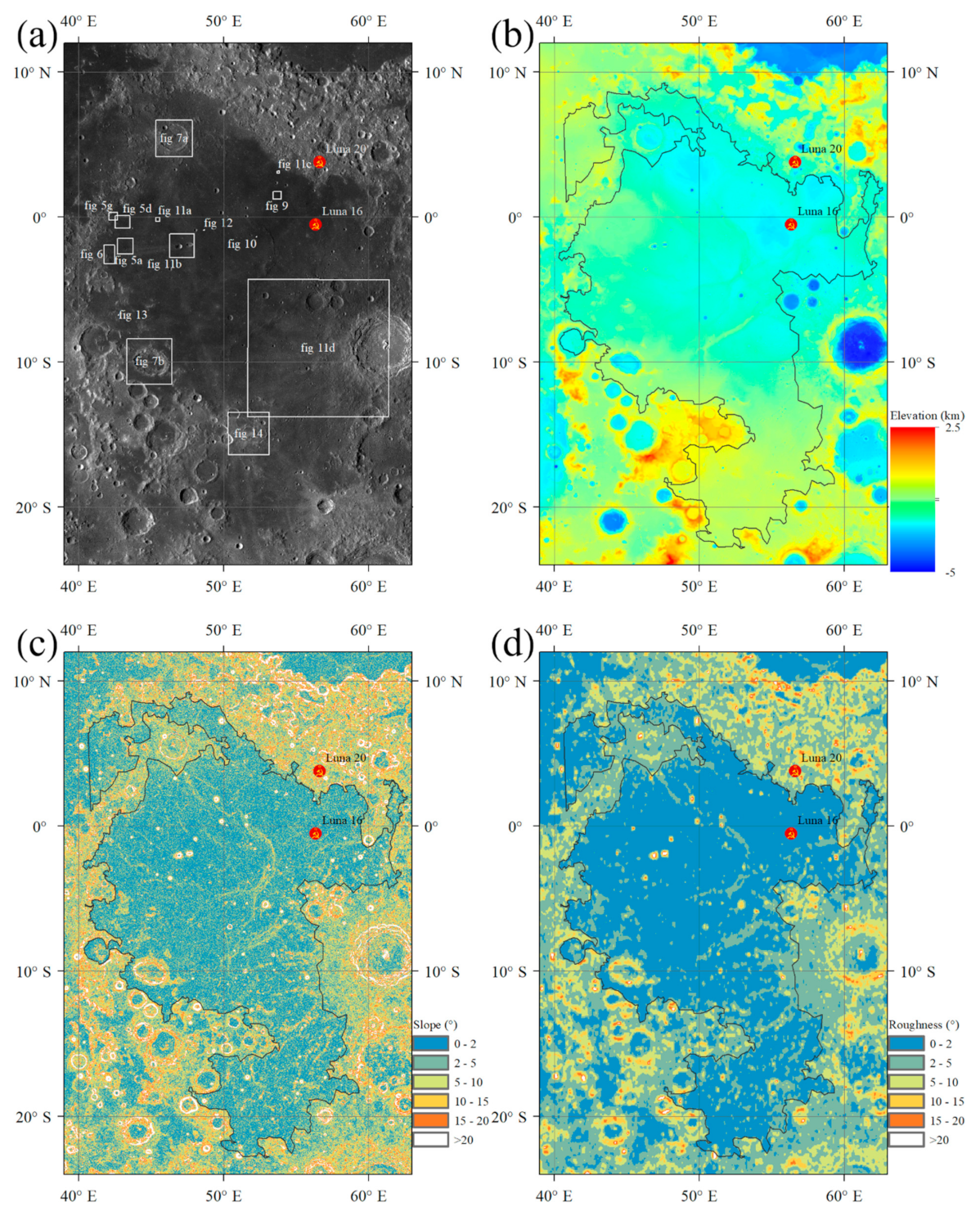
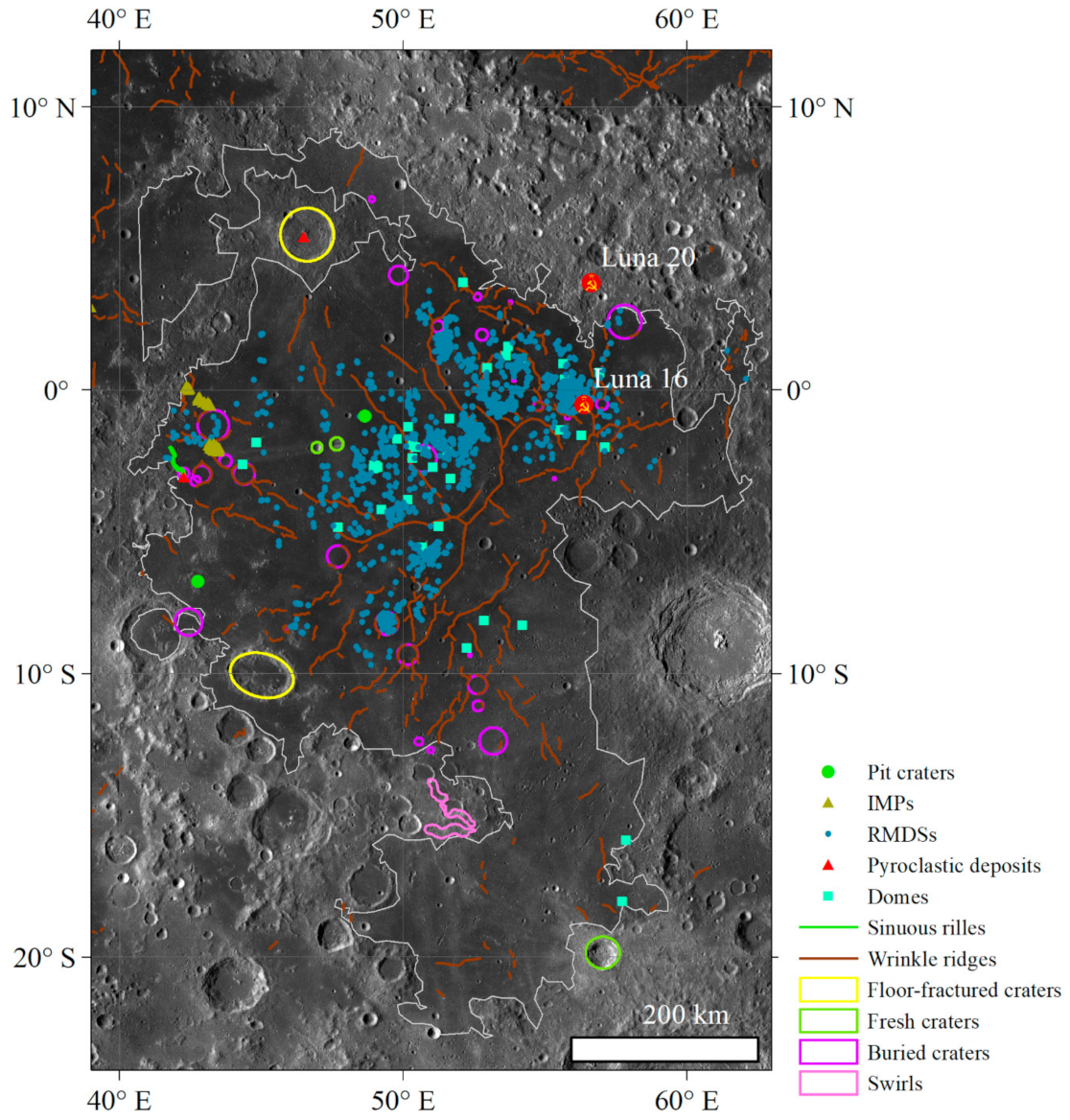

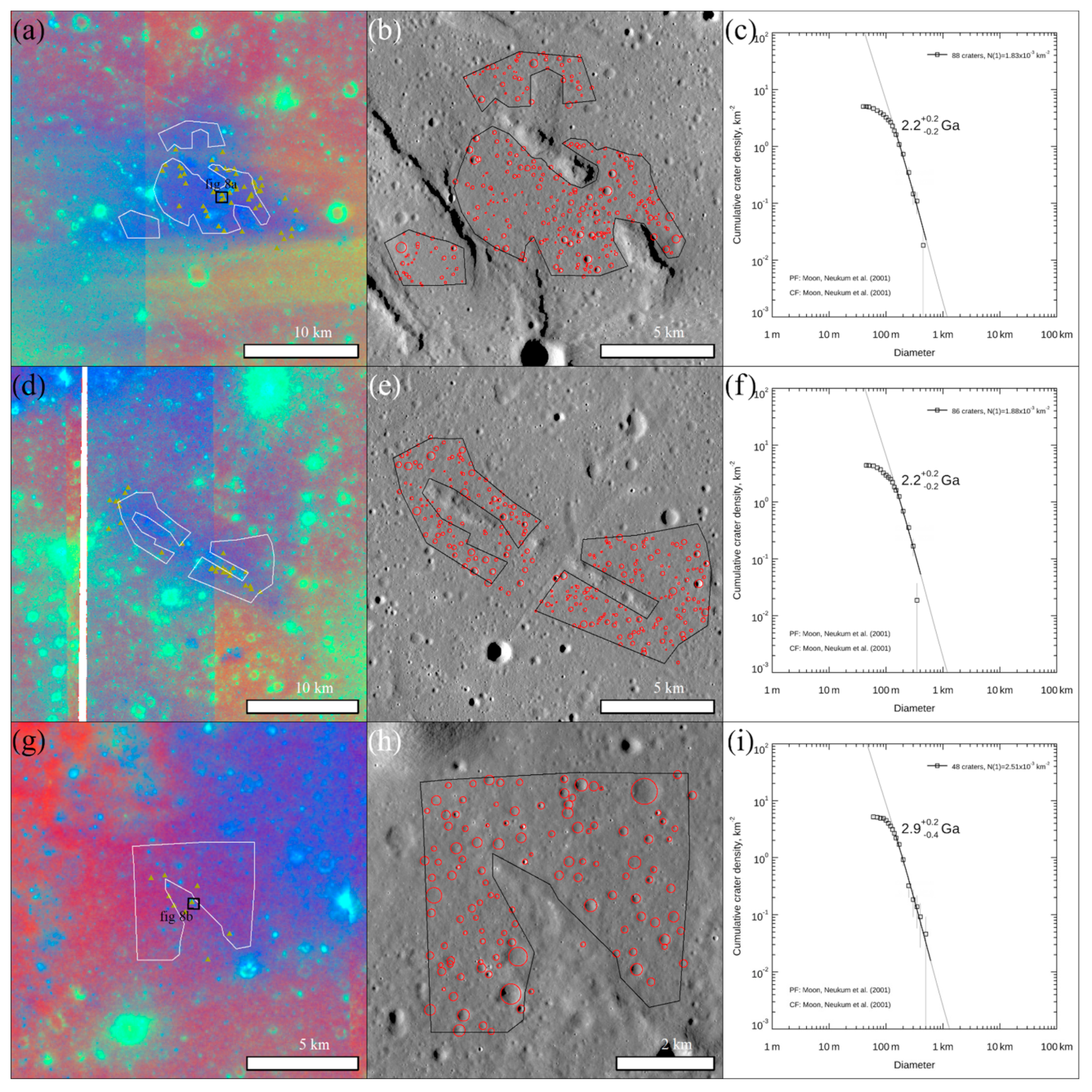
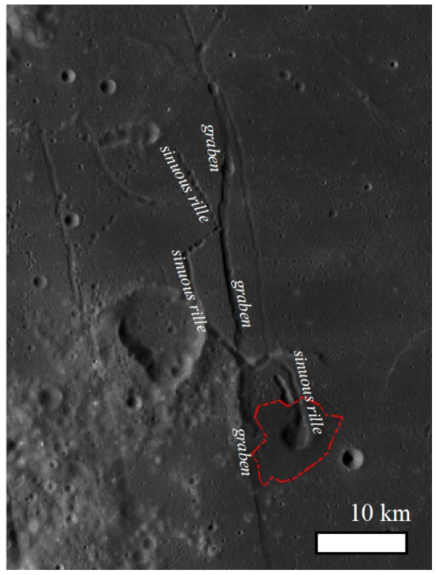
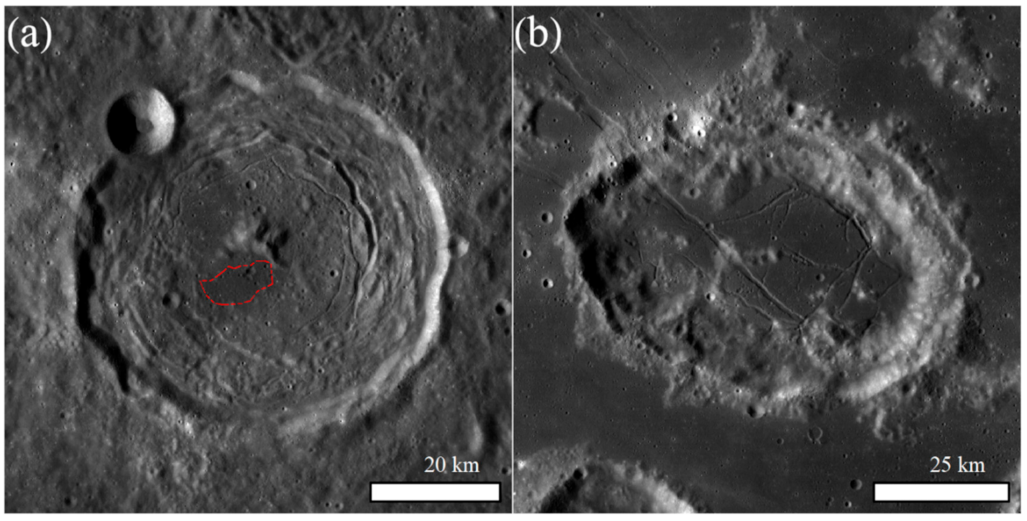

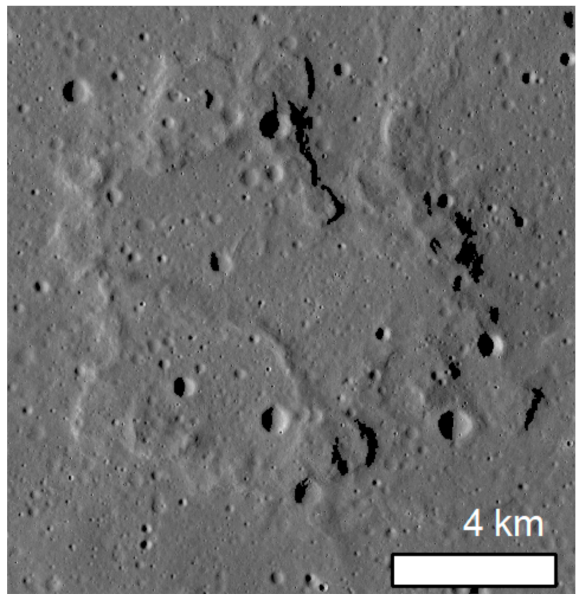
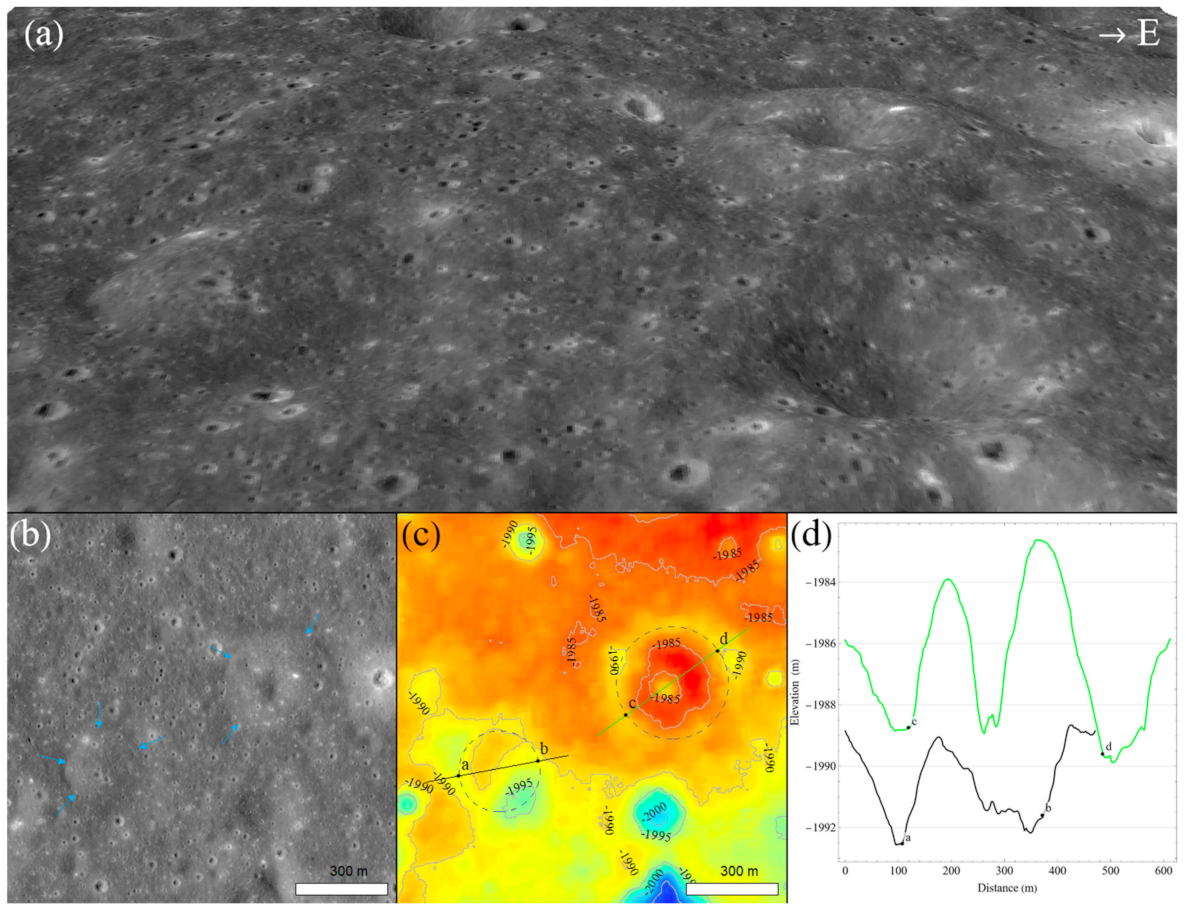
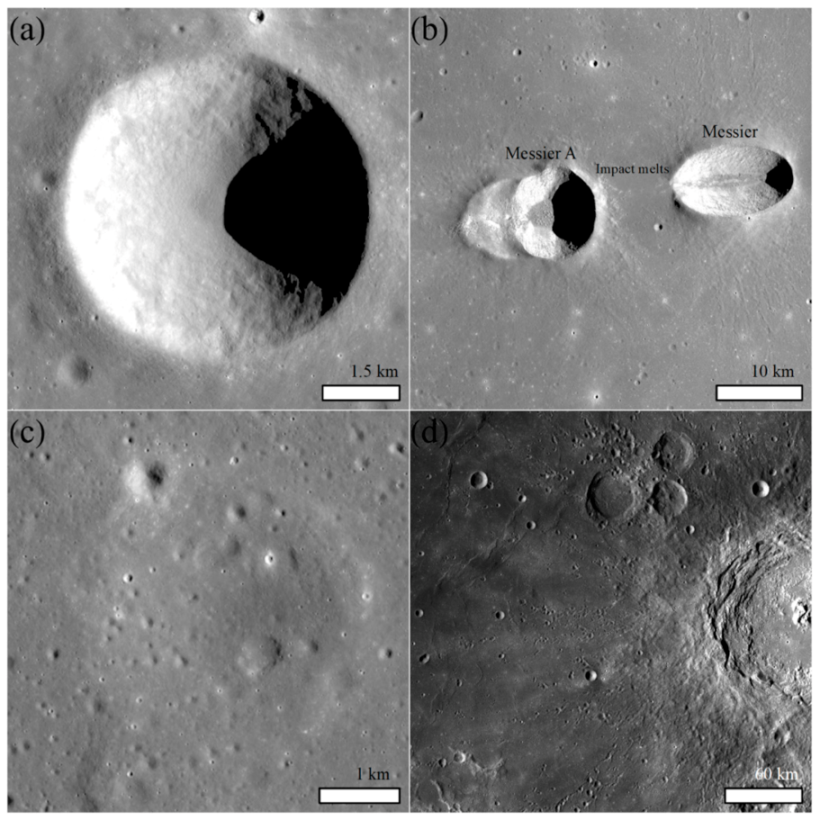


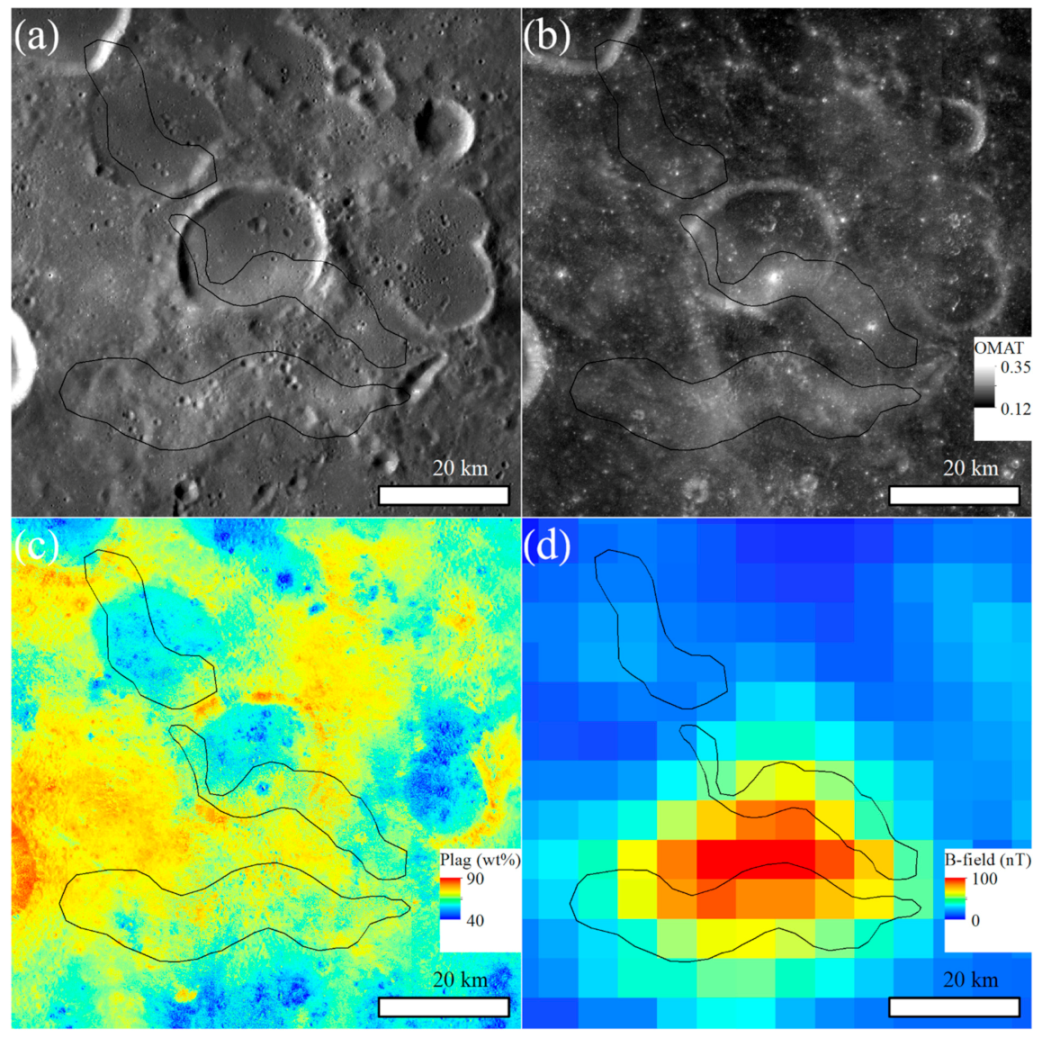
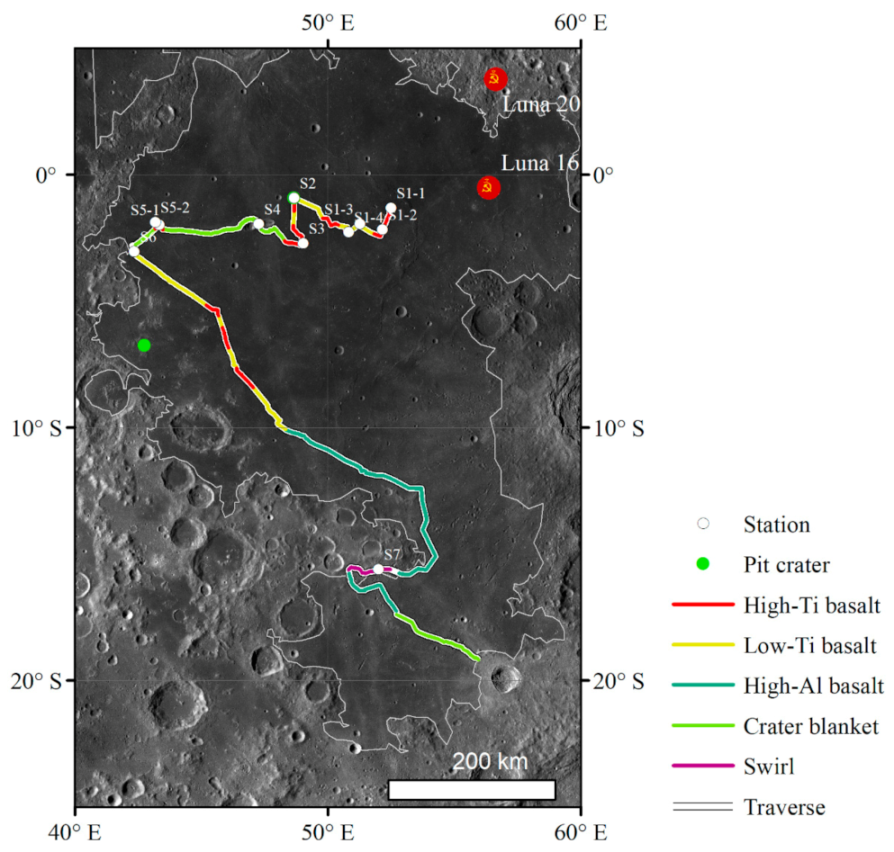
| Rover | Landing Time | Travel Distance | Travel Time | Average Speed | Top Speed |
|---|---|---|---|---|---|
| Lunokhod 1 | 1970 | 10.54 km | 321 days | 0.97 km/lunar day | 0.1 km/h |
| Lunar Roving Vehicle (Apollo 15) | 1971 | 27.76 km | 3 h 02 min | 9.15 km/h | 13 km/h |
| Lunar Roving Vehicle (Apollo 16) | 1972 | 26.55 km | 3 h 26 min | 7.73 km/h | 13 km/h |
| Lunar Roving Vehicle (Apollo 17) | 1972 | 35.89 km | 4 h 26 min | 8.10 km/h | 13 km/h |
| Lunokhod 2 | 1973 | 39 km | 136 days | 8.46 km/lunar day | 2 km/h |
| Yutu | 2013 | 0.1148 km | 42 days | 80.63 m/lunar day | 0.2 km/h |
| Yutu-2 | 2018 | 1.0039 km (10 January 2022) | 1103 days | 26.85 m/lunar day | 0.2 km/h |
| Intrepid | - | 1800 km | 4 years | 37.5 km/lunar day | 1 km/h |
| Fengfu (this study) | - | 1400 km | 5 years | 22.58 km/lunar day | 1 km/h |
| Station | Latitude | Longitude | Exploration Time (Lunar Day) | Description |
|---|---|---|---|---|
| S1-1 | 1.31471° S | 52.5026° E | 1 | RMDS (High-Ti) |
| S1-2 | 2.16267° S | 52.1579° E | 1 | RMDS (Low-Ti) |
| S1-3 | 1.95172° S | 51.265° E | 1 | RMDS (Low-Ti) |
| S1-4 | 2.26975° S | 50.8258° E | 1 | RMDS and Dome |
| S2 | 0.917° S | 48.66° E | 5 | Pit crater |
| S3 | 2.71559° S | 49.0189° E | 1 | Dome |
| S4 | 1.94542° S | 47.2645° E | 1 | Impact melt |
| S5-1 | 1.883° S | 43.176° E | 1 | IMP in a crater |
| S5-2 | 2.16852° S | 43.4695° E | 1 | IMP on the mare |
| S6 | 3.04264° S | 42.348° E | 1 | Pyroclastic deposits and Sinuous rilles |
| S7 | 15.607° S | 51.9968° E | 1 | Swirl |
| Exploration traverse: High-Ti basalt, Low-Ti basalt, High-Al basalt, Impact blanket, and Swirl | ||||
Publisher’s Note: MDPI stays neutral with regard to jurisdictional claims in published maps and institutional affiliations. |
© 2022 by the authors. Licensee MDPI, Basel, Switzerland. This article is an open access article distributed under the terms and conditions of the Creative Commons Attribution (CC BY) license (https://creativecommons.org/licenses/by/4.0/).
Share and Cite
Zhao, S.; Qian, Y.; Xiao, L.; Zhao, J.; He, Q.; Huang, J.; Wang, J.; Chen, H.; Xu, W. Lunar Mare Fecunditatis: A Science-Rich Region and a Concept Mission for Long-Distance Exploration. Remote Sens. 2022, 14, 1062. https://doi.org/10.3390/rs14051062
Zhao S, Qian Y, Xiao L, Zhao J, He Q, Huang J, Wang J, Chen H, Xu W. Lunar Mare Fecunditatis: A Science-Rich Region and a Concept Mission for Long-Distance Exploration. Remote Sensing. 2022; 14(5):1062. https://doi.org/10.3390/rs14051062
Chicago/Turabian StyleZhao, Siyuan, Yuqi Qian, Long Xiao, Jiannan Zhao, Qi He, Jun Huang, Jiang Wang, Hui Chen, and Weiyang Xu. 2022. "Lunar Mare Fecunditatis: A Science-Rich Region and a Concept Mission for Long-Distance Exploration" Remote Sensing 14, no. 5: 1062. https://doi.org/10.3390/rs14051062
APA StyleZhao, S., Qian, Y., Xiao, L., Zhao, J., He, Q., Huang, J., Wang, J., Chen, H., & Xu, W. (2022). Lunar Mare Fecunditatis: A Science-Rich Region and a Concept Mission for Long-Distance Exploration. Remote Sensing, 14(5), 1062. https://doi.org/10.3390/rs14051062








